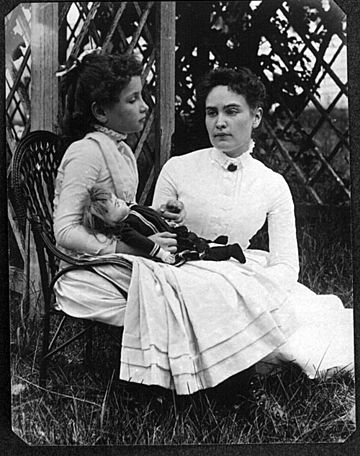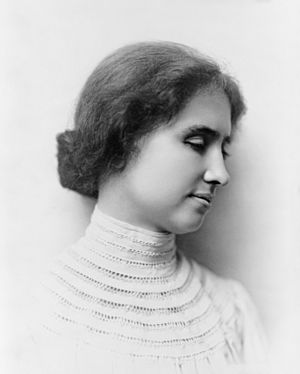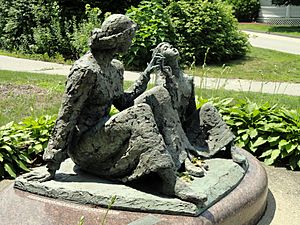Helen Keller facts for kids
Quick facts for kids
Helen Keller
|
|
|---|---|
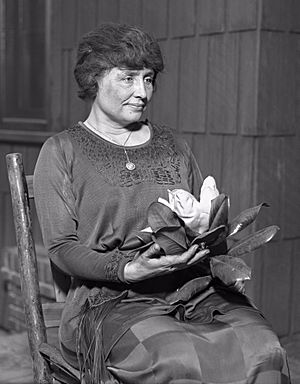
Keller holding a magnolia, c. 1920
|
|
| Born | Helen Adams Keller June 27, 1880 Tuscumbia, Alabama, U.S. |
| Died | June 1, 1968 (aged 87) Easton, Connecticut, U.S. |
| Resting place | Washington National Cathedral |
| Occupation |
|
| Education | Radcliffe College (BA) |
| Notable works | The Story of My Life (1903) |
| Signature | |
Helen Adams Keller (June 27, 1880 – June 1, 1968) was an American author, disability rights advocate, political activist and lecturer. Despite her medical condition, Keller attended Radcliffe College of Harvard University and became the first deafblind person to earn a Bachelor of Arts degree in the United States. She was named one of Time magazine's 100 Most Important People of the 20th Century.
Contents
Early childhood and illness
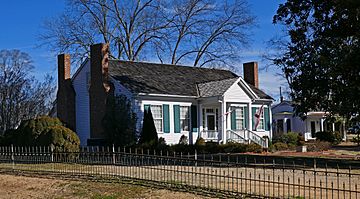
Keller was born on June 27, 1880, in Tuscumbia, Alabama, to Arthur Henley Keller (1836–1896) and Catherine Everett (Adams) Keller (1856–1921), known as "Kate". Her family lived on a homestead, Ivy Green, that Helen's paternal grandfather had built decades earlier. She had four siblings: two full siblings, Mildred Campbell (Keller) Tyson and Phillip Brooks Keller; and two older half-brothers from her father's first marriage, James McDonald Keller and William Simpson Keller.
When she was nineteen months old, she became sick and lost her eyesight and hearing. The doctor did not know what it was, so he called it a "congestion of the stomach and brain." Some people say that it was scarlet fever or meningitis.She lived, as she recalled in her autobiography, "at sea in a dense fog".
She was usually an obedient and good girl, but not being able to communicate sometimes made Helen angry. At that time, Keller was able to communicate somewhat with Martha Washington, the daughter of the family cook, who was two years older. Shed understood the girl's signs. By the age of seven, Keller had more than 60 home signs to communicate with her family, and could distinguish people by the vibration of their footsteps.
Around this time, Keller's mother got inspired by an account in Charles Dickens' American Notes of the successful education of Laura Bridgman, a deaf and blind woman, and decided to look for a teacher for her daughter. At the advice of Alexander Graham Bell, who was working with deaf children at the time, she contacted the Perkins Institute for the Blind, the school where Bridgman had been educated. Michael Anagnos, the school's director, asked Anne Sullivan, a 20-year-old alumna of the school who was visually impaired, to become Keller's instructor. It was the beginning of a nearly 50-year-long relationship: Sullivan became Keller's governess and later her companion.
Learning to read
Sullivan arrived at Keller's house on March 5, 1887, a day Keller would forever remember as "my soul's birthday". Sullivan immediately began to teach Helen to communicate by spelling words into her hand, beginning with "d-o-l-l" for the doll that she had brought Keller as a present.
At first, Keller was not successful as she could not comprehend that every object had a word identifying it. When Sullivan was trying to teach Keller the word for "mug", Keller became so frustrated she broke the mug. But soon Keller began to imitate Sullivan's hand gestures "in monkey-like imitation."
The next month Keller made a breakthrough, when she realized that the motions her teacher was making on the palm of her hand, while running cool water over her other hand, symbolized the idea of "water".
Writing in her autobiography, The Story of My Life, Keller recalled the moment:
I stood still, my whole attention fixed upon the motions of her fingers. Suddenly I felt a misty consciousness as of something forgotten—a thrill of returning thought; and somehow the mystery of language was revealed to me. I knew then that w-a-t-e-r meant the wonderful cool something that was flowing over my hand. The living word awakened my soul, gave it light, hope, set it free!
Keller quickly demanded that Sullivan sign the names of all the other familiar objects in her world.
Formal education
- In May 1888, Keller started attending the Perkins Institute for the Blind.
- In 1894, Keller and Sullivan moved to New York to attend the Wright-Humason School for the Deaf, and to learn from Sarah Fuller at the Horace Mann School for the Deaf. *In 1896, they returned to Massachusetts, and Keller entered The Cambridge School for Young Ladies.
- In 1900, she was admitted to Radcliffe College of Harvard University, where she lived in Briggs Hall, South House.
- In 1904, at the age of 24, Keller graduated as a member of Phi Beta Kappa from Radcliffe, becoming the first deaf-blind person to earn a Bachelor of Arts degree.
Companions

Anne Sullivan stayed as a companion to Helen Keller long after she taught her. Sullivan married John Macy in 1905, and her health started failing around 1914. Polly Thomson (February 20, 1885 – March 21, 1960) was hired to keep house. She was a young woman from Scotland who had no experience with deaf or blind people. She progressed to working as a secretary as well, and eventually became a constant companion to Keller.
Keller moved to Forest Hills, Queens, together with Sullivan and Macy, and used the house on behalf of the American Foundation for the Blind. Keller had moved with her mother in Montgomery, Alabama.
Anne Sullivan died in 1936, with Keller holding her hand, after falling into a coma as a result of coronary thrombosis. After her death, Keller and Thomson moved to Connecticut. They traveled worldwide and raised funds for the blind. Thomson had a stroke in 1957 from which she never fully recovered and died in 1960. Winnie Corbally, a nurse originally hired to care for Thomson in 1957, stayed on after Thomson's death and was Keller's companion for the rest of her life.
Career, writing and political activities
The few own the many because they possess the means of livelihood of all ... The country is governed for the richest, for the corporations, the bankers, the land speculators, and for the exploiters of labor. The majority of mankind are working people. So long as their fair demands—the ownership and control of their livelihoods—are set at naught, we can have neither men's rights nor women's rights. The majority of mankind is ground down by industrial oppression in order that the small remnant may live in ease.
On January 22, 1916, Keller and Sullivan traveled to the small town of Menomonie in western Wisconsin to deliver a lecture at the Mabel Tainter Memorial Building. Very soon Keller became a world-famous speaker and author. She was an advocate for people with disabilities, amid numerous other causes.
She traveled to twenty-five different countries giving motivational speeches about Deaf people's conditions. She was a suffragist, pacifist, radical socialist, and opponent of Woodrow Wilson. In 1915, she and George A. Kessler founded the Helen Keller International (HKI) organization. This organization is devoted to research in vision, health, and nutrition.
In 1909 Keller became a member of the Socialist Party.
In 1916, she sent money to the NAACP, as she was ashamed of the Southern un-Christian treatment of "colored people".
In 1920, Keller helped to found the American Civil Liberties Union (ACLU). She traveled to over 40 countries with Sullivan, making several trips to Japan and becoming a favorite of the Japanese people.
Keller worked for the American Foundation for the Blind (AFB) from 1924 until 1968. From 1946 to 1957 Keller visited 35 countries advocating for those with vision loss.
Personal life
In her thirties Helen had a love affair and became secretly engaged to the fingerspelling socialist Peter Fagan, a young Boston Herald reporter who was sent to Helen's home to act as her private secretary when lifelong companion, Anne, fell ill. She wanted to run away with her fiance.
Her family and Anne Sullivan strongly objected to her marriage because they believed that women with disabilities should not marry. The engagement was cancelled. Helen never married and had no children.
Works
Keller was also a prolific author, writing 14 books and hundreds of speeches and essays on topics ranging from animals to Mahatma Gandhi.
At age 22, Keller published her autobiography, The Story of My Life (1903), with help from Sullivan and Sullivan's husband, John Macy. It recounts the story of her life up to age 21 and was written during her time in college. It was adapted as a play by William Gibson, and this was also adapted as a film under the same title, The Miracle Worker.
Keller wrote The World I Live In in 1908, giving readers an insight into how she felt about the world.
Helen Keller's writings
- "The Frost King" (1891)
- The Story of My Life (1903)
- Optimism: an essay (1903) T. Y. Crowell and company
- My Key of Life: Optimism (1904), Isbister
- The World I Live In (1908)
- The miracle of life (1909) Hodder and Stoughton
- The song of the stone wall (1910) The Century co.
- Out of the Dark, a series of essays on socialism (1913)
- Uncle Sam Is Calling (set to music by Pauline B. Story) (1917)
- My Religion (1927; also called Light in My Darkness)
- Midstream: my later life (1929) Doubleday, Doran & company
- We bereaved.(1929) L. Fulenwider, Inc
- Peace at eventide (1932) Methuen & co. ltd
- Helen Keller in Scotland: a personal record written by herself (1933) Methuen, 212pp
- Helen Keller's journal (1938) M. Joseph, 296pp
- Let us have faith (1940), Doubleday, & Doran & co., inc.
- Teacher: Anne Sullivan Macy: a tribute by the foster-child of her mind. (1955), Doubleday (publisher)
- The open door (1957), Doubleday, 140pp
- The faith of Helen Keller (1967)
- Helen Keller: her socialist years, writings and speeches (1967)
Later life and death
Keller had a series of strokes in 1961 and spent the last years of her life at her home.
Keller devoted much of her later life to raising funds for the American Foundation for the Blind. She died in her sleep on June 1, 1968, at her home, Arcan Ridge, located in Easton, Connecticut, a few weeks short of her eighty-eighth birthday. A service was held at the Washington National Cathedral in Washington, D.C., and her body was cremated in Bridgeport, Connecticut. Her ashes were buried at the Washington National Cathedral next to her constant companions, Anne Sullivan and Polly Thomson.
Hellen Keller quotes
- "There is no king who has not had a slave among his ancestors, and no slave who has not had a king among his".
- "I owed my success partly to the advantages of my birth and environment. I have learned that the power to rise is not within the reach of everyone."
- "The true test of a character is to face hard conditions with the determination to make them better."
- "We are never really happy until we try to brighten the lives of others."
- "We live by each other and for each other. Alone we can do so little; together we can do so much."
- "Keep your face to the sunshine and you cannot see the shadows."
Interesting facts about Helen Keller
- Keller had Swiss ancestors. One of them was the first teacher for the deaf in Zurich.
- Her family was rich and owned slaves.
- Keller was able to enjoy music by feeling the beat and she was able to have a strong connection with animals through touch.
- Although she was delayed at picking up language, that did not stop her from having a voice.
- Keller supported eugenics which had become popular in the early 20th century.
- Mark Twain was Keller's great admirer. He introduced her to Standard Oil magnate Henry Huttleston Rogers, who, with his wife Abbie, paid for her education.
- She exchanged letters with the Austrian philosopher and pedagogue Wilhelm Jerusalem, who was one of the first to discover her literary talent.
- At age 11 she wrote The Frost King (1891). There were allegations that this story had been plagiarized from The Frost Fairies by Margaret Canby.
- Determined to communicate with others as conventionally as possible, Keller learned to speak and spent much of her life giving speeches and lectures on aspects of her life.
- She learned to "hear" people's speech using the Tadoma method, which means using her fingers to feel the lips and throat of the speaker.
- She became proficient at using braille and using fingerspelling to communicate.
- Shortly before World War I, with the assistance of the Zoellner Quartet, she determined that by placing her fingertips on a resonant tabletop she could experience music played close by.
- Keller met every U.S. president from Grover Cleveland to Lyndon B. Johnson and was friends with many famous figures, including Alexander Graham Bell and Charlie Chaplin.
- On September 14, 1964, President Lyndon B. Johnson awarded her the Presidential Medal of Freedom, one of the United States' two highest civilian honors.
- In 1965 she was elected to the National Women's Hall of Fame at the New York World's Fair.
- Keller was inducted into the Alabama Women's Hall of Fame in 1971.
- She was one of twelve inaugural inductees to the Alabama Writers Hall of Fame on June 8, 2015.
- Her birthplace has been designated and preserved as a National Historic Landmark. In 1954, it became a house museum. It sponsors an annual "Helen Keller Day".
Portrayals
Keller's life has been interpreted many times. She appeared in a silent film, Deliverance (1919), which told her story in a melodramatic, allegorical style.
She was also the subject of the Academy Award-winning 1954 documentary Helen Keller in Her Story, narrated by her friend and noted theatrical actress Katharine Cornell. She was also profiled in The Story of Helen Keller, part of the Famous Americans series produced by Hearst Entertainment.
The Miracle Worker is a cycle of dramatic works ultimately derived from her autobiography, The Story of My Life. The various dramas each describe the relationship between Keller and Sullivan, depicting how the teacher led her from a state of almost feral wildness into education, activism, and intellectual celebrity. The common title of the cycle echoes Mark Twain's description of Sullivan as a "miracle worker". Its first realization was the 1957 Playhouse 90 teleplay of that title by William Gibson. He adapted it for a Broadway production in 1959 and an Oscar-winning feature film in 1962, starring Anne Bancroft and Patty Duke. It was remade for television in 1979 and 2000."

An anime movie called The Story of Helen Keller: Angel of Love and Light was made in 1981.
In 1984, Keller's life story was made into a TV movie called The Miracle Continues. This film, a semi-sequel to The Miracle Worker, recounts her college years and her early adult life. None of the early movies hint at the social activism that would become the hallmark of Keller's later life, although a Disney version produced in 2000 states in the credits that she became an activist for social equality.
The Bollywood movie Black (2005) was largely based on Keller's story, from her childhood to her graduation.
A documentary called Shining Soul: Helen Keller's Spiritual Life and Legacy was produced by the Swedenborg Foundation in the same year. The film focuses on the role played by Emanuel Swedenborg's spiritual theology in her life and how it inspired Keller's triumph over her triple disabilities of blindness, deafness and a severe speech impediment.
On March 6, 2008, the New England Historic Genealogical Society announced that a staff member had discovered a rare 1888 photograph showing Helen and Anne, which, although previously published, had escaped widespread attention. Depicting Helen holding one of her many dolls, it is believed to be the earliest surviving photograph of Anne Sullivan Macy.
Video footage showing Helen Keller speaking also exists.
A biography of Helen Keller was written by the German Jewish author Hildegard Johanna Kaeser.
A 10-by-7-foot (3.0 by 2.1 m) painting titled The Advocate: Tribute to Helen Keller was created by three artists from Kerala, India as a tribute to Helen Keller. The Painting was created in association with a non-profit organization Art d'Hope Foundation, artists groups Palette People and XakBoX Design & Art Studio. This painting was created for a fundraising event to help blind students in India and was inaugurated by M. G. Rajamanikyam, IAS (District Collector Ernakulam) on Helen Keller day (June 27, 2016). The painting depicts the major events of Helen Keller's life and is one of the biggest paintings done based on Helen Keller's life.
In 2020, the documentary essay Her Socialist Smile by John Gianvito evolves around Keller's first public talk in 1913 before a general audience, when she started speaking out on behalf of progressive causes.
Posthumous honors
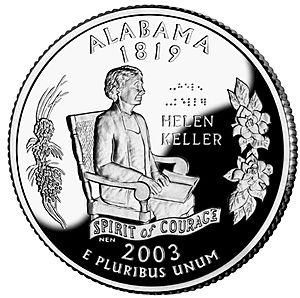
In 1999, Keller was listed in Gallup's Most Widely Admired People of the 20th century.
In 1999, Keller was named one of Time magazine's 100 Most Important People of the 20th Century.
In 2003, Alabama honored its native daughter on its state quarter. The Alabama state quarter is the only circulating U.S. coin to feature braille.
The Helen Keller Hospital in Sheffield, Alabama, is dedicated to her.
Streets are named after Helen Keller in Zürich, Switzerland; in the U.S, in Getafe, Spain; in Lod, Israel, in Lisbon, Portugal, and in Caen, France.
A preschool for the deaf and hard of hearing in Mysore, India, was originally named after Helen Keller by its founder, K. K. Srinivasan.
A stamp was issued in 1980 by the United States Postal Service depicting Keller and Sullivan, to mark the centennial of Keller's birth. That year her birth was also recognized by a presidential proclamation from U.S. President Jimmy Carter. Pennsylvania annually commemorates her June 27 birthday as Helen Keller Day.
On October 7, 2009, the State of Alabama donated a bronze statue of Keller to the National Statuary Hall Collection, as a replacement for its 1908 statue of education reformer Jabez Lamar Monroe Curry.
See also
 In Spanish: Helen Keller para niños
In Spanish: Helen Keller para niños


